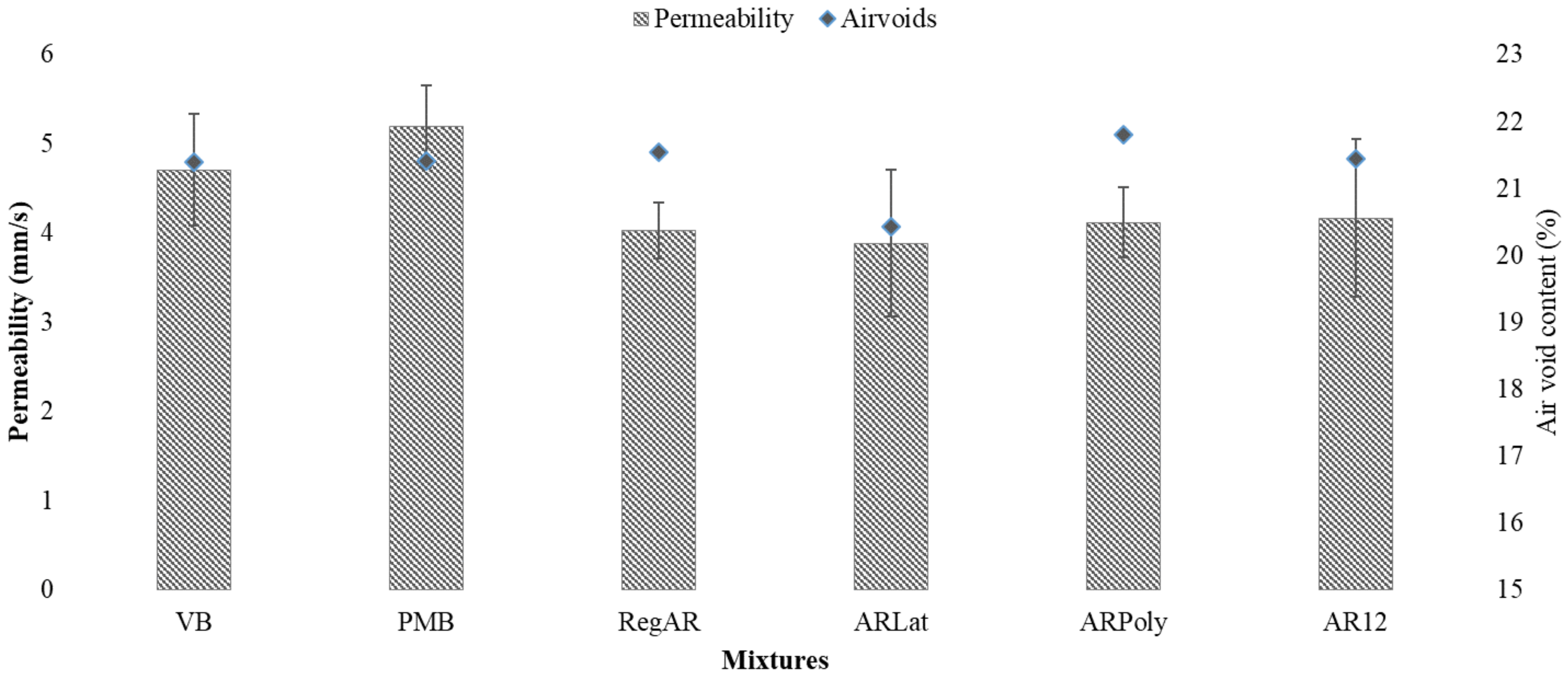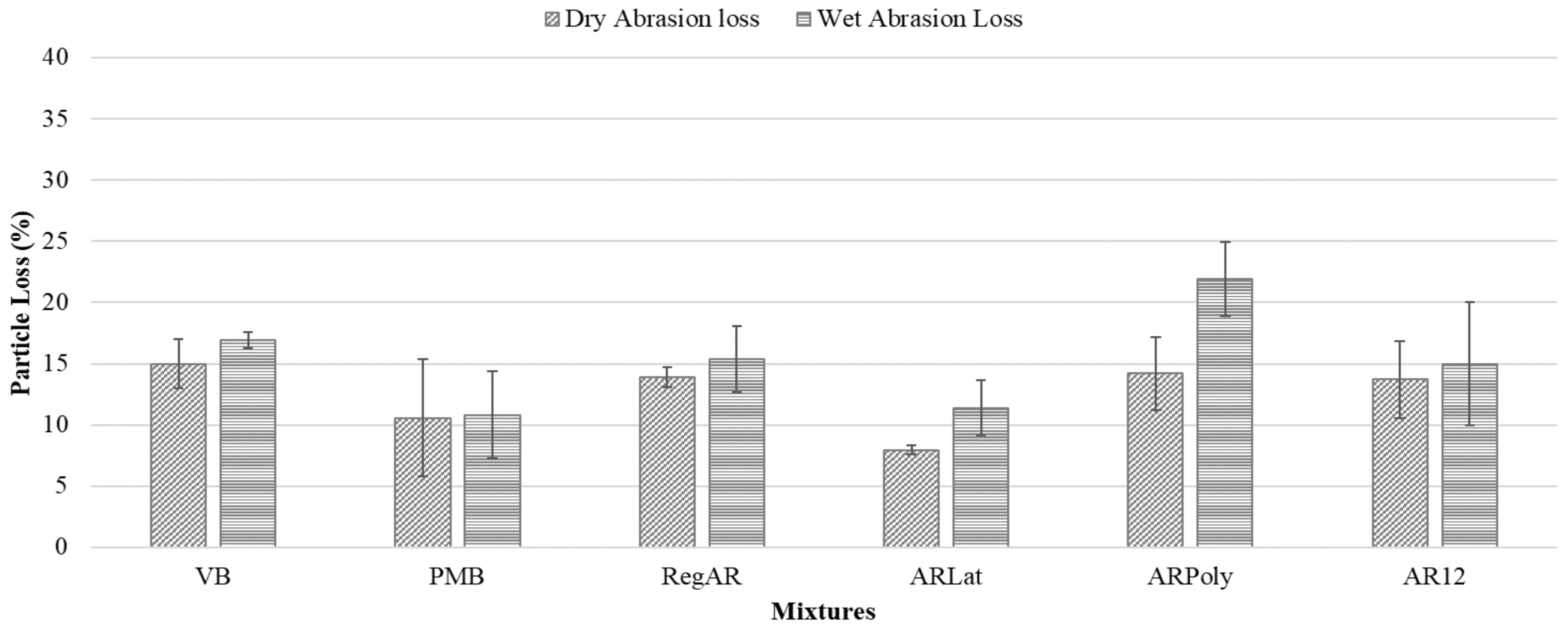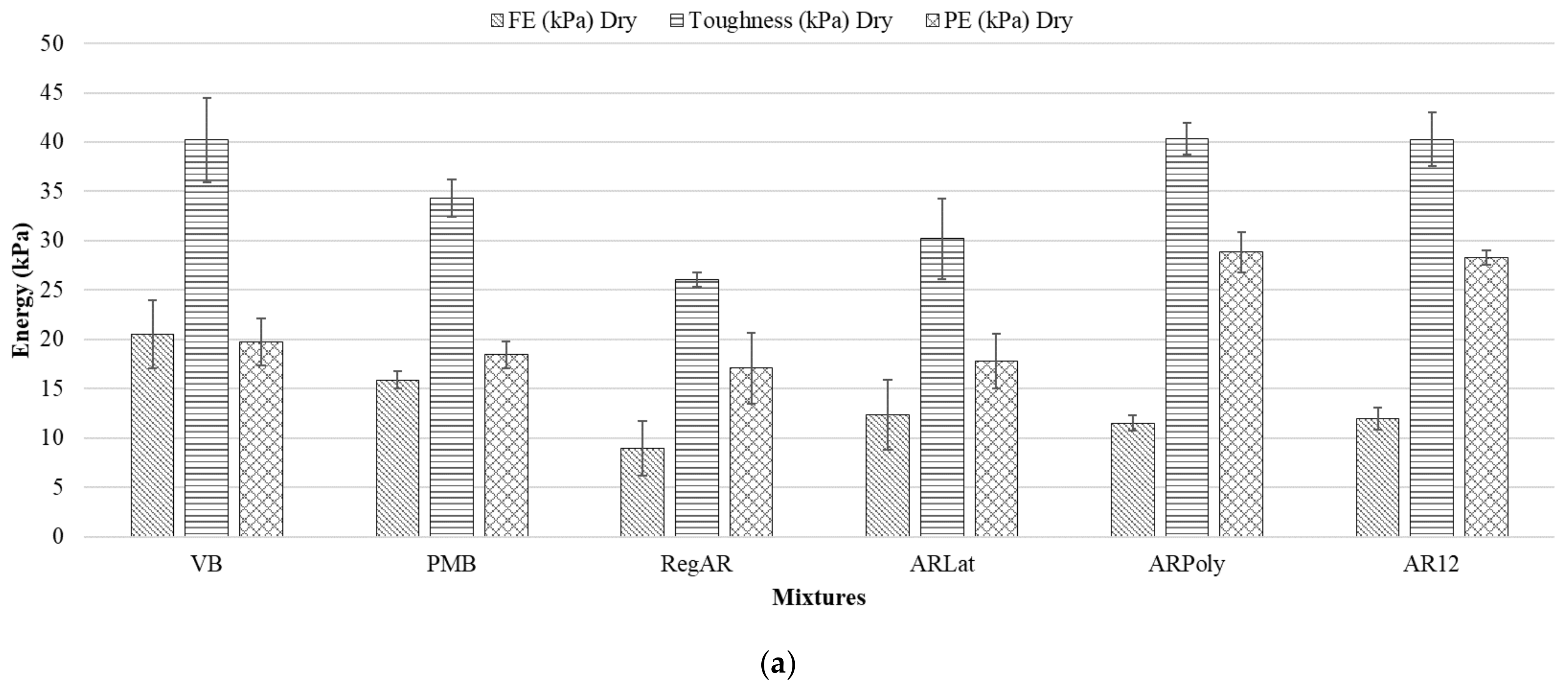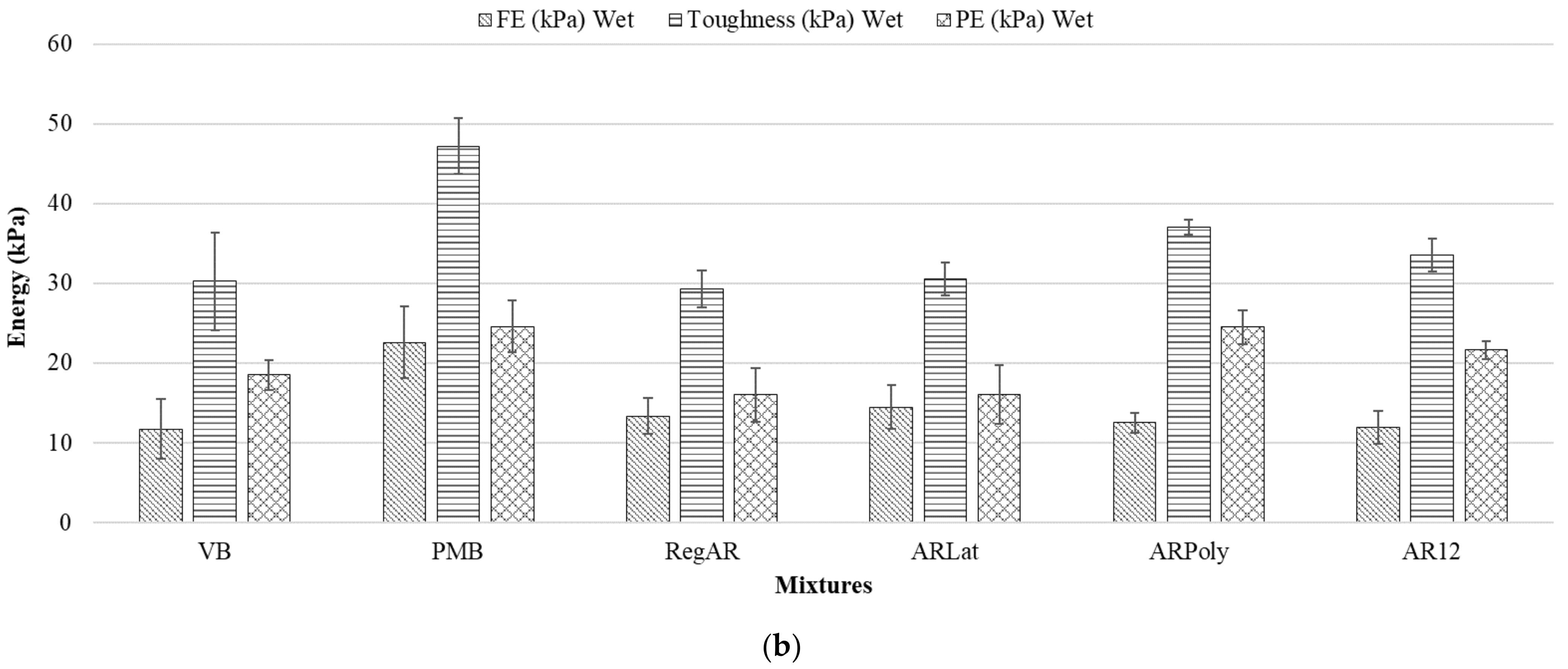Laboratory Characterization of Porous Asphalt Mixtures with Aramid Fibers
Abstract
1. Introduction
1.1. Background
1.2. Aramid Fibers
1.3. Objective and Methodology
2. Materials and Methods
2.1. Permeability Test
2.2. Cantabro Test
2.3. Indirect Tensile Strength Test
2.4. Statistical Analysis
3. Results and Discussion
3.1. Air Voids and Permeability
3.2. Cantabro Test
3.3. Indirect Tensile Strength Test
3.4. Toughness
4. Conclusions
- With this percentage of binder, the addition of fibers had a negligible influence on the permeability of porous asphalt mixtures. The air void contents of all the mixtures with fibers were quite similar and exceeded 20%.
- Aramid fibers enhanced the abrasion resistance of the mixtures. ARLat fibers displayed the best performance with similar results to PMB. While ARPoly reduced the abrasion resistance of the mixtures under wet conditions.
- All aramid fibers were shown to have a positive effect on the dry ITS values of porous asphalt mixtures, although the observed increment was low. Particularly, ARPoly and RegAR fibers improve the ITS under dry conditions by up to 8% and 10%, respectively.
- Under wet conditions, the fibers considerably reduce the ITS of porous asphalt mixtures. This may be because of the high susceptibility of aramid fibers to the presence of moisture or to requiring higher bitumen content. Additionally, it was found that the polymer coating on fibers minimized the damage caused due to penetration of moisture; as coated fibers (ARPoly and ARLat) showed better results in comparison to uncoated aramid fibers.
- Concerning the post cracking energy, significant improvement was observed by incorporation of polyurethane coating (ARPoly) and use of higher length fibers (AR12) fibers under dry conditions. The possible explanation may be polyurethane coating increases the durability while a higher length of fibers of AR12 facilitates more deformation at the same stress. Meanwhile, shorter length (RegAR) and latex coated fibers ARLat had adverse effects on post cracking energy.
- Aramid fibers had a negative impact on the fracture energy of porous asphalt mixtures in dry conditions, but their impact is negligible under wet conditions. The fibers did not achieve the behavior of PMB.
- Overall, aramid fibers were found to be susceptible to moisture, which is reflected by reduction in ITS and toughness of the mixtures under wet conditions. Higher percentages of binder would be required to facilitate the strengthening and anti-drainage capacity of the aramid fibers.
Author Contributions
Funding
Institutional Review Board Statement
Informed Consent Statement
Data Availability Statement
Acknowledgments
Conflicts of Interest
References
- Mo, L.; Huurman, M.; Woldekidan, M.; Wu, S.; Molenaar, A. Investigation into material optimization and development for improved ravelling resistant porous asphalt concrete. Mater. Des. 2010, 31, 3194–3206. [Google Scholar] [CrossRef]
- Mansour, T.N.; Putman, B.J. Influence of Aggregate Gradation on the Performance Properties of Porous Asphalt Mixtures. J. Mater. Civ. Eng. 2013, 25, 281–288. [Google Scholar] [CrossRef]
- Gupta, A.; Rodriguez-Hernandez, J.; Castro-Fresno, D. Incorporation of Additives and Fibers in Porous Asphalt Mixtures: A Review. Materials 2019, 12, 3156. [Google Scholar] [CrossRef] [PubMed]
- James, T.; Watson, D.; Taylor, A.; Tran, N.; Rodezno, C. Improving cohesiveness of porous friction course asphalt mixtures. Road Mater. Pavement Des. 2017, 18, 256–272. [Google Scholar] [CrossRef]
- Nakanishi, H.; O Hamzah, M.; Hasan, M.R.M.; Karthigeyan, P.; Shaur, O. Mix design and application of porous asphalt pavement using Japanese technology. IOP Conf. Ser. Mater. Sci. Eng. 2019, 512, 012026. [Google Scholar] [CrossRef]
- Nowoświat, A.; Sorociak, W.; Żuchowski, R. The impact of the application of thin emulsion mat microsurfacing on the level of noise in the environment. Constr. Build. Mater. 2020, 263, 120626. [Google Scholar] [CrossRef]
- Jellema, E.; Vonk, W. Improving durability and functionality retention of porous asphalt by using high performing bituminous binders. In Proceedings of the 6th Eurasphalt & Eurobitume Congress, Prague, Czech Republic, 1–3 June 2016. [Google Scholar]
- Lu, X.; Sandman, B.; Redelius, P. Aging Characteristics of Polymer Modified Binders in Porous Asphalt Pavements. In Proceedings of the 11th International Conference of Asphalt Pavement, Nagoya, Japan, 1–6 August 2010. [Google Scholar]
- Malarvizhi, G.; Kamaraj, C.; Athira, P.K.; Jain, P.K.; Gangopadhyay, S. Design of open-graded frictional course (OGFC) in pavements with polymer modified bitumen. Int. J. Appl. Eng. Res. 2015, 10, 20067–20080. [Google Scholar]
- Landi, D.; Marconi, M.; Bocci, E.; Germani, M. Comparative life cycle assessment of standard, cellulose-reinforced and end of life tires fiber-reinforced hot mix asphalt mixtures. J. Clean. Prod. 2020, 248, 119295. [Google Scholar] [CrossRef]
- Masri, K.A.; Awang, H.; Jaya, R.P.; Ali, M.I.; Ramli, N.I.; Arshad, A.K. Moisture susceptibility of porous asphalt mixture ith Nano silica modified asphalt binder. IOP Conf. Ser. Earth Environ. Sci. 2019, 244. Available online: https://iopscience.iop.org/article/10.1088/1755-1315/244/1/012028 (accessed on 1 February 2021). [CrossRef]
- Cheng, Y.; Chai, C.; Liang, C.; Chen, Y. Mechanical Performance of Warm-Mixed Porous Asphalt Mixture with Steel Slag and Crumb-Rubber–SBS Modified Bitumen for Seasonal Frozen Regions. Materials 2019, 12, 857. [Google Scholar] [CrossRef]
- Shukry, N.A.M.; Hassan, N.A.; Abdullah, M.E.; Hainin, M.R.; Yusoff, N.I.M.; Jaya, R.P.; Mohamed, A. Effect of various filler types on the properties of porous asphalt mixture. IOP Conf. Ser. Mater. Sci. Eng. 2018, 342, 012036. [Google Scholar] [CrossRef]
- Haryati, Y.; Norhidayah, A.H.; Nordiana, M.; Juraidah, A.; Hayati, A.H.N.; Ramadhansyah, P.J.; Azman, M.K.; Haryati, A. Stability and rutting resistance of porous asphalt mixture incorporating coconut shells and fibres. IOP Conf. Ser. Earth Environ. Sci. 2019, 244, 012043. [Google Scholar] [CrossRef]
- Syammaun, T.; Yati, R. Effect of coconut-shell ash as filler and plastic bottle as substitution of porous asphalt mixture. IOP Conf. Ser. Mater. Sci. Eng. 2020, 821. [Google Scholar] [CrossRef]
- Skaf, M.; Pasquini, E.; Revilla-Cuesta, V.; Ortega-López, V. Performance and Durability of Porous Asphalt Mixtures Manufactured Exclusively with Electric Steel Slags. Materials 2019, 12, 3306. [Google Scholar] [CrossRef]
- Tanzadeh, J.; Shahrezagamasaei, R. Laboratory Assessment of Hybrid Fiber and Nano-silica on Reinforced Porous Asphalt Mixtures. Constr. Build. Mater. 2017, 144, 260–270. [Google Scholar] [CrossRef]
- Chawla, K.K.; Chawla, N. Fibrous Reinforcements for Composites, Comprehensive Composite Materials II, Reference Module in Materials Science and Materials Engineering; Elsevier: Amsterdam, The Netherlands, 2018; Volume 1, pp. 1–12. [Google Scholar] [CrossRef]
- Ertekin, M. Aramid Fibers in Fiber Technology for Fiber-Reinforced Composites; Composites Science and Engineering; Woodhead Publishing: Cambridge, UK, 2017; pp. 153–167. [Google Scholar]
- Ash, R.A. Vehicle armor. In Lightweight Ballistic Composites: Military and Law-Enforcement Applications, 2nd ed.; Woodhead Publishing: Cambridge, UK, 2016; pp. 285–309. [Google Scholar] [CrossRef]
- Bueno, M.; Poulikakos, L.D. Chemo-Mechanical Evaluation of Asphalt Mixtures Reinforced With Synthetic Fibers. Front. Built Environ. 2020, 6, 1–9. [Google Scholar] [CrossRef]
- Gupta, A.; Slebi-Acevedo, C.J.; Lizasoain-Arteaga, E.; Rodriguez-Hernandez, J.; Castro-Fresno, D. Multi-Criteria Selection of Additives in Porous Asphalt Mixtures Using Mechanical, Hydraulic, Economic, and Environmental Indicators. Sustainability 2021, 13, 2146. [Google Scholar] [CrossRef]
- Mitchell, M.R.; Link, R.E.; Kaloush, K.E.; Biligiri, K.P.; Zeiada, W.A.; Rodezno, M.C.; Reed, J.X. Evaluation of Fiber-Reinforced Asphalt Mixtures Using Advanced Material Characterization Tests. J. Test. Eval. 2010, 38, 102442. [Google Scholar] [CrossRef]
- Klinsky, L.; Kaloush, K.; Faria, V.; Bardini, V. Performance characteristics of fiber modified hot mix asphalt. Constr. Build. Mater. 2018, 176, 747–752. [Google Scholar] [CrossRef]
- Kassem, H.A.; Saleh, N.F.; Zalghout, A.A.; Chehab, G.R. Advanced Characterization of Asphalt Concrete Mixtures Reinforced with Synthetic Fibers. J. Mater. Civ. Eng. 2018, 30, 04018307. [Google Scholar] [CrossRef]
- Pszczola, M.; Szydlowski, C.; Jaczewski, M. Influence of cooling rate and additives on low-temperature properties of asphalt mixtures in the TSRST. Constr. Build. Mater. 2019, 204, 399–409. [Google Scholar] [CrossRef]
- Wiśniewski, D.; Słowik, M.; Kempa, J.; Lewandowska, A.; Malinowska, J. Assessment of Impact of Aramid Fibre Addition on the Mechanical Properties of Selected Asphalt Mixtures. Materials 2020, 13, 3302. [Google Scholar] [CrossRef]
- Noorvand, H.; Castro, S.; Underwood, B.S.; Kaloush, K.E. Evaluating interaction of fibre reinforcement mechanism with mesostructure of asphalt concrete. Int. J. Pavement Eng. 2020, 1–18. [Google Scholar] [CrossRef]
- Xing, X.; Liu, T.; Pei, J.; Huang, J.; Li, R.; Zhang, J.; Tian, Y. Effect of fiber length and surface treatment on the performance of fiber-modified binder. Constr. Build. Mater. 2020, 248, 118702. [Google Scholar] [CrossRef]
- Takaikaew, T.; Tepsriha, P.; Horpibulsuk, S.; Hoy, M.; Kaloush, K.E.; Arulrajah, A. Performance of Fiber-Reinforced Asphalt Concretes with Various Asphalt Binders in Thailand. J. Mater. Civ. Eng. 2018, 30, 04018193. [Google Scholar] [CrossRef]
- Xing, X.; Pei, J.; Shen, C.; Li, R.; Zhang, J.; Huang, J.; Hu, D. Performance and Reinforcement Mechanism of Modified Asphalt Binders with Nano-Particles, Whiskers, and Fibers. Appl. Sci. 2019, 9, 2995. [Google Scholar] [CrossRef]
- Badeli, S.; Carter, A.; Doré, G.; Saliani, S. Evaluation of the durability and the performance of an asphalt mix involving Aramid Pulp Fiber (APF): Complex modulus before and after freeze-thaw cycles, fatigue, and TSRST tests. Constr. Build. Mater. 2018, 174, 60–71. [Google Scholar] [CrossRef]
- Tafti, M.F.; Aqda, S.A.H.; Motamedi, H. The impacts of type and proportion of five different asphalt modifiers on the low temperature fracture toughness and fracture energy of modified HMA. Frat. Integrità Strutt. 2018, 13, 169–185. [Google Scholar] [CrossRef]
- Al-Bared, M.A.M.; Marto, A. Evaluating the compaction behaviour of soft marine clay stabilized with two sizes of recycled crushed tiles. In GCEC 2017; Springer: Singapore, 2018. [Google Scholar] [CrossRef]
- Xing, X.; Chen, S.; Li, Y.; Pei, J.; Zhang, J.; Wen, Y.; Li, R.; Cui, S. Effect of different fibers on the properties of asphalt mastics. Constr. Build. Mater. 2020, 262, 120005. [Google Scholar] [CrossRef]
- Daniel, G. Assessing the impact of the incorporation of aramid and polyolefin to hot and warm asphaltic mixture using dry and wet process: A Review. IOP Conf. Ser. Mater. Sci. Eng. 2020, 930. [Google Scholar] [CrossRef]
- Gupta, A.; Castro-Fresno, D.; Lastra-Gonzalez, P.; Rodriguez-Hernandez, J. Selection of fibers to improve porous asphalt mixtures using multi-criteria analysis. Constr. Build. Mater. 2021, 266, 121198. [Google Scholar] [CrossRef]
- Slebi-Acevedo, C.J.; Lastra-González, P.; Calzada-Pérez, M.A.; Castro-Fresno, D. Effect of Synthetic Fibers and Hydrated Lime in Porous Asphalt Mixture Using Multi-Criteria Decision-Making Techniques. Materials 2020, 13, 675. [Google Scholar] [CrossRef]
- Slebi-Acevedo, C.J.; Pascual-Muñoz, P.; Lastra-González, P.; Castro-Fresno, D. Multi-Response Optimization of Porous Asphalt Mixtures Reinforced with Aramid and Polyolefin Fibers Employing the CRITIC-TOPSIS Based on Taguchi Methodology. Materials 2019, 12, 3789. [Google Scholar] [CrossRef]
- PG-3 Pliego de Prescripciones Técnicas Generales Para Obras de Carreteras y Puentes; Ediciones Liteam SL: Madrid, Spain, 2010.
- Gupta, A.; Rodriguez-Hernandez, J.; Slebi-Acevedo, C.J.; Castro-Fresno, D. Improving porous asphalt mixes by incorporation of additives. In Proceedings of the TRA2020, the 8th Transport Research Arena: Rethinking Transport–Towards Clean and Inclusive Mobility Transport Research Arena, Helsinki, Finland, 27–30 April 2020. [Google Scholar] [CrossRef]
- Hansen, K.R. Porous Asphalt Pavements for Stormwater Management; National Asphalt Pavement Association: Greenbelt, MD, USA, 2008; p. 30. [Google Scholar]
- Kandhal, P.S. Design, Construction and Maintenance of Open-Graded Asphalt Friction Courses; National Asphalt Pavement Association: Greenbelt, MD, USA, 2002; p. 29. [Google Scholar]
- Chen, J.-S.; Sun, Y.-C.; Liao, M.-C.; Huang, C.-C. Effect of Binder Types on Engineering Properties and Performance of Porous Asphalt Concrete. Transp. Res. Rec. J. Transp. Res. Board 2012, 2293, 55–62. [Google Scholar] [CrossRef]
- Chen, M.J.; Wong, Y.D. Porous asphalt mixture with 100% recycled concrete aggregate. Road Mater. Pavement Des. 2013, 14, 921–932. [Google Scholar] [CrossRef]
- Aman, M.Y.; Shahadan, Z.; Noh, M.Z.M. A Comparative Study of Anti-Stripping Additives in Porous Asphalt Mixtures. J. Teknol. 2014, 70, 139–145. [Google Scholar] [CrossRef]
- Cetin, A. Effects of Crumb Rubber Size and Concentration on Performance of Porous Asphalt Mixtures. Int. J. Polym. Sci. 2013, 2013, 1–10. [Google Scholar] [CrossRef]
- Andrés-Valeri, V.C.; Rodriguez-Torres, J.; Calzada-Perez, M.A.; Rodriguez-Hernandez, J. Exploratory study of porous asphalt mixtures with additions of reclaimed tetra pak material. Constr. Build. Mater. 2018, 160, 233–239. [Google Scholar] [CrossRef]
- Sangiorgi, C.; Tataranni, P.; Simone, A.; Vignali, V.; Lantieri, C.; Dondi, G. Assessment of waste bleaching clay as alternative filler for the production of porous asphalts. Constr. Build. Mater. 2016, 109, 1–7. [Google Scholar] [CrossRef]
- ASCE. Permeable Pavements: Recommended Design Guidelines; American Society of Civil Engineers: Reston, VG, USA, 2013. [Google Scholar]
- Mallick, R.B.; Kandhal, P.S.; Allen Cooley, L., Jr.; Watson, D.E. Design, Construction, and Performance of New-Generation Open-Graded. 2000. Available online: https://www.researchgate.net/publication/238741997 (accessed on 1 February 2021).
- Kim, K.W.; El Hussein, M. Variation of fracture toughness of asphalt concrete under low temperatures. Constr. Build. Mater. 1997, 11, 403–411. [Google Scholar] [CrossRef]







| Properties | Standard | Virgin Binder 50/70 | PMB 45/80-65 |
|---|---|---|---|
| Relative Density | EN 15326 | 1.035 | 1.028 |
| Penetration (0.1 mm) | EN 1426 | 57 | 55 |
| Softening point (°C) | EN 1427 | 51.6 | 74.1 |
| Frass point (°C) | EN 12593 | −13 | - |
| Elastic Recovery at 25 °C (%) | EN 13398 | - | 92 |
| Fibers | ||||
| Properties | RegAR | ARLat | ARPoly | AR12 |
| Coating | none | Resorcinal formaldehyde latex (RFL) | Polyurethane | none |
| Density (g/cc) | 1.39 | 1.39 | 1.44 | 1.44 |
| tensile strength (GPa) | 3.2–3.5 | 3.2–3.5 | 2.7–3.6 | 2.7–3.6 |
| Length (mm) | 6 | 6 | 6 | 12 |
| Moisture (%) | 1.9 | 1.9 | 2.7 | 2.7 |
| Mineral Aggregates | ||||
| Properties | Standard | Coarse Aggregates | Fine Aggregates | Limits |
| Specific Weight (g/cm3) | EN 1097-6 | 2.787 | 2.705 | - |
| Los Angeles (%) | EN 1097-2 | 15 | - | ≤15% |
| Flakiness Index (%) | EN 933-3 | 12 | - | ≤20% |
| Sand equivalent (%) | EN 933-8 | - | 78 | >55 |
| Short Name of Mixtures | Bitumen | Fiber Content (by wt. of Mix) | Bitumen Content (by wt. of Mix) |
|---|---|---|---|
| VB | Virgin binder 50/70 | - | 4.5 |
| PMB | 45/80-65 | - | |
| RegAR | Virgin binder 50/70 | 0.05 | |
| ARLat | Virgin binder 50/70 | 0.05 | |
| ARPoly | Virgin binder 50/70 | 0.05 | |
| AR12 | Virgin binder 50/70 | 0.05 |
| Authors | Minimum Permeability (mm/day) | Standards |
|---|---|---|
| Cetin 2013 [47]; Andres-Valeri 2018 [48] | 1.15 | ASTM D7064-04, ASTM D3637 |
| Sangiorgi 2016 [49] | 0.5 | Italian technical specifications |
| ASCE 2013 [50] | 1.2 | - |
| Mallick et al. [51] | 1.16 | - |
| Mixture | p-Value | Group | Percent Change w.r.t VB (%) | Percent Change w.r.t PMB (%) |
|---|---|---|---|---|
| Dry conditions | ||||
| VB | <0.05 | A | - | - |
| PMB | A, B | - | - | |
| RegAR | A | ↑ 7.2 | ↓ 31.65 | |
| ARLat | B | ↑ 46.9 | ↑ 24.72 | |
| ARPoly | A | ↑ 5.3 | ↓ 34.29 | |
| AR12 | A | ↑ 8.7 | ↓ 29.57 | |
| Wet conditions | ||||
| VB | <0.05 | A, B | - | - |
| PMB | B | - | - | |
| RegAR | A, B | ↑ 8.99 | ↓ 42.21 | |
| ARLat | B | ↑ 32.60 | ↓ 5.32 | |
| ARPoly | A | ↓ 29.59 | ↓ 102.50 | |
| AR12 | A, B | ↑ 11.24 | ↓ 38.70 |
| Mixture | p-Value | Group | Percent Change w.r.t VB (%) | Percent Change w.r.t PMB (%) |
|---|---|---|---|---|
| Dry conditions | ||||
| VB | <0.05 | A | - | - |
| PMB | A, B | - | - | |
| RegAR | B, C | ↑ 8.3 | ↓ 0.1 | |
| ARLat | C | ↑ 2.9 | ↓ 5.1 | |
| ARPoly | A, B, | ↑ 10 | ↑ 1.4 | |
| AR12 | A, B, C | ↑ 5.8 | ↓ 2.4 | |
| Wet conditions | ||||
| VB | <0.05 | A | - | - |
| PMB | A | - | - | |
| RegAR | C | ↓ 27.3 | ↓ 32.9 | |
| ARLat | B, C | ↓ 20.6 | ↓ 26.7 | |
| ARPoly | B | ↓ 15.5 | ↓ 22.1 | |
| AR12 | C | ↓ 27.7 | ↓ 33.3 |
| Mixture | Group | Percent Change w.r.t VB (%) | Percent Change w.r.t PMB (%) |
|---|---|---|---|
| Dry conditions | |||
| VB | A, B | - | - |
| PMB | B, C | - | - |
| RegAR | A, B | ↓ 35.23 | ↓ 24.14 |
| ARLat | C | ↓ 24.86 | ↓ 12.00 |
| ARPoly | A | ↑ 0.32 | ↑ 17.50 |
| AR12 | A | ↑ 0.22 | ↑ 17.38 |
| Wet conditions | |||
| VB | A, B | - | - |
| PMB | A | - | - |
| RegAR | D | ↓ 3.14 | ↓ 37.89 |
| ARLat | C | ↑ 1.02 | ↓ 35.23 |
| ARPoly | B, C | ↑ 22.39 | ↓ 21.52 |
| AR12 | C | ↑ 10.91 | ↓ 28.89 |
Publisher’s Note: MDPI stays neutral with regard to jurisdictional claims in published maps and institutional affiliations. |
© 2021 by the authors. Licensee MDPI, Basel, Switzerland. This article is an open access article distributed under the terms and conditions of the Creative Commons Attribution (CC BY) license (https://creativecommons.org/licenses/by/4.0/).
Share and Cite
Gupta, A.; Lastra-Gonzalez, P.; Castro-Fresno, D.; Rodriguez-Hernandez, J. Laboratory Characterization of Porous Asphalt Mixtures with Aramid Fibers. Materials 2021, 14, 1935. https://doi.org/10.3390/ma14081935
Gupta A, Lastra-Gonzalez P, Castro-Fresno D, Rodriguez-Hernandez J. Laboratory Characterization of Porous Asphalt Mixtures with Aramid Fibers. Materials. 2021; 14(8):1935. https://doi.org/10.3390/ma14081935
Chicago/Turabian StyleGupta, Anik, Pedro Lastra-Gonzalez, Daniel Castro-Fresno, and Jorge Rodriguez-Hernandez. 2021. "Laboratory Characterization of Porous Asphalt Mixtures with Aramid Fibers" Materials 14, no. 8: 1935. https://doi.org/10.3390/ma14081935
APA StyleGupta, A., Lastra-Gonzalez, P., Castro-Fresno, D., & Rodriguez-Hernandez, J. (2021). Laboratory Characterization of Porous Asphalt Mixtures with Aramid Fibers. Materials, 14(8), 1935. https://doi.org/10.3390/ma14081935







